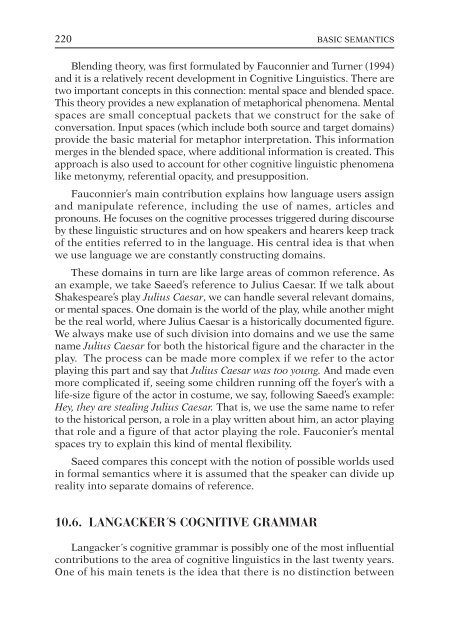Semantics
Create successful ePaper yourself
Turn your PDF publications into a flip-book with our unique Google optimized e-Paper software.
220 BASIC SEMANTICS<br />
Blending theory, was first formulated by Fauconnier and Turner (1994)<br />
and it is a relatively recent development in Cognitive Linguistics. There are<br />
two important concepts in this connection: mental space and blended space.<br />
This theory provides a new explanation of metaphorical phenomena. Mental<br />
spaces are small conceptual packets that we construct for the sake of<br />
conversation. Input spaces (which include both source and target domains)<br />
provide the basic material for metaphor interpretation. This information<br />
merges in the blended space, where additional information is created. This<br />
approach is also used to account for other cognitive linguistic phenomena<br />
like metonymy, referential opacity, and presupposition.<br />
Fauconnier’s main contribution explains how language users assign<br />
and manipulate reference, including the use of names, articles and<br />
pronouns. He focuses on the cognitive processes triggered during discourse<br />
by these linguistic structures and on how speakers and hearers keep track<br />
of the entities referred to in the language. His central idea is that when<br />
we use language we are constantly constructing domains.<br />
These domains in turn are like large areas of common reference. As<br />
an example, we take Saeed’s reference to Julius Caesar. If we talk about<br />
Shakespeare’s play Julius Caesar, we can handle several relevant domains,<br />
or mental spaces. One domain is the world of the play, while another might<br />
be the real world, where Julius Caesar is a historically documented figure.<br />
We always make use of such division into domains and we use the same<br />
name Julius Caesar for both the historical figure and the character in the<br />
play. The process can be made more complex if we refer to the actor<br />
playing this part and say that Julius Caesar was too young. And made even<br />
more complicated if, seeing some children running off the foyer’s with a<br />
life-size figure of the actor in costume, we say, following Saeed’s example:<br />
Hey, they are stealing Julius Caesar. That is, we use the same name to refer<br />
to the historical person, a role in a play written about him, an actor playing<br />
that role and a figure of that actor playing the role. Fauconier’s mental<br />
spaces try to explain this kind of mental flexibility.<br />
Saeed compares this concept with the notion of possible worlds used<br />
in formal semantics where it is assumed that the speaker can divide up<br />
reality into separate domains of reference.<br />
10.6. LANGACKER´S COGNITIVE GRAMMAR<br />
Langacker´s cognitive grammar is possibly one of the most influential<br />
contributions to the area of cognitive linguistics in the last twenty years.<br />
One of his main tenets is the idea that there is no distinction between



